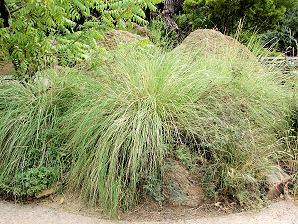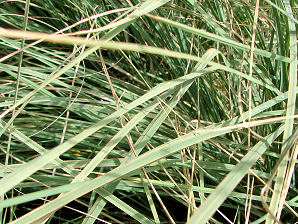Xeriscape Landscape Plants & Flowers
For The Arizona Desert Environment.
Pictures, Photos, Images, Descriptions, & Reviews.
Deer Grass, Muhlenbergia rigens.
We Are Proud Of Our SafeSurf Rating!
Click On Any Of The Following Links By Amazon.Com
For Books, & Videos About Wildflowers Of Arizona & The Southwest USA. No Obligation!
 |
| Deer Grass, Muhlenbergia rigens. Photo September 29, 2006. Arizona - Sonora Desert Museum. Near Tucson, Arizona. |
|---|
 |  |
| Deer Grass. Muhlenbergia rigens. | Deer Grass. Muhlenbergia rigens. |
|---|
Deer Grass. Muhlenbergia rigens, Grass Family ( Poaceae ), Deer Grass. Also Called: Deergrass, Prairie Grama, Epicampes rigens, Muhlenbergia marshii, Muhlenbergia mundula. We wish to thank Wikipedia, the free encyclopedia for some of the information on this page. We share images and information with Wikipedia. Deer Grass can grow 4 - 5 feet in height and spread over 6 feet wide. Long silver-gray flower panicles arch gracefully 3 feet over the gray-green foliage. Extremely adaptable. Once established Deer Grass can go without water, which also regulates its height. It also tolerates regular garden water, which keeps the foliage nearly evergreen. Use Deer Grass in mass plantings or as a single specimen. Deer Grass should be mowed every few years. This is to stimulate its growth. The mowing should be done in the fall, after it has gone to seed. In its native habitats, it inhabits a wide range of ecotypes including grassland, riparian, chaparral, mixed conifer, and oak woodland communities. Deergrass can grow in areas with periodic flooding, but cannot tolerate standing water and poorly drained soils. It prefers full sun but is shade-tolerant.
Quick Notes:
Height: Height normally about 48 inches tall. Will also spread to about 48 inches. Can be 5 feet high with a 6 foot spread.
Flowers: Silver - gray flower panicles.
Flowering Time: Phoenix Arizona. Mid August - September.
Leaves: Simple, graye - green; medium blade width.
Found: The USDA claims it is native to the USA (AZ, CA, NM, NV, TX). Also found in northern Mexico in the states of Baja Norte, Chihuahua, Coahuila, Durango, Nuevo Leon, Sonora, Tamaulipas, Zacatecas.
Hardiness:
Soil pH requirements:
Sun Exposure:
Elevation: Prefers 2,500 - 7,000 feet. Will grow at lower elevations.
Habitat: Rocky open slopes, shallow woodlands and forest openings up to an elevation of 7,000 feet.
Miscellaneous: Great xeriscape plant. Photos Taken September 29, 2006. Arizona - Sonora Desert Museum. Near Tucson, Arizona.
More Details:
Culms: Erect, solid, 10 to 40 inches tall, glabrous, purplish at the nodes. They are in clumps or sometimes just a few together.
Blades: Numerous blades, flat, from 2 to 12 inches long, scabrous above and on the margins, smooth beneath. Tiny hairs grow out of tiny bumps on the blade margins, especially near the ligule.
Sheaths: Usually shorter than the internodes, striate, glabrous below to somewhat pilose above. The collar is frequently pilose on the margins.
Ligules: Very short fringed membrane, truncate.
Inflorescence: A panicle, 3 to16 inches long, with 20 to 60 spike-like branches, each one-sided and 1/2 to 3/4 inch long. The individual branches are angled to one side of the rachis and they hang down.
Spikelets: There are 3 to 8 spikelets per branch with one perfect floret and one imperfect floret. Lemma has three short, unequal awns.
|
We Are Proud Of Our SafeSurf Rating!
Click On Any Of The Following Links By Amazon.Com
For Books, & Videos About Wildflowers Of Arizona & The Southwest USA. No Obligation!
| © 1966 - Present, Audrey, Eve, & George DeLange |
